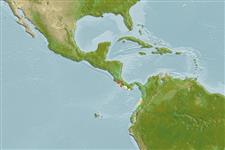Actinopterygii (ray-finned fishes) >
Perciformes (Perch-likes) >
Opistognathidae (Jawfishes)
Etymology: Opistognathus: Greek, opisthe = behind + Greek, gnathos = jaw (Ref. 45335).
Environment / Climate / Range
Ecology
Marine; demersal; depth range 63 - 72 m (Ref. 13250). Tropical, preferred ?
Eastern Pacific: Colombia and Costa Rica.
Size / Weight / Age
Maturity: Lm ? range ? - ? cm
Max length : 27.1 cm TL male/unsexed; (Ref. 13250)
Short description
Morphology | Morphometrics
Dorsal
spines
(total): 11;
Dorsal
soft rays
(total): 13;
Anal
spines: 3;
Anal
soft rays: 13;
Vertebrae: 26. This large (13.2-21.8 cm SL) species have the following set of characters: truncate caudal fin;
D 13, A III; 102-105 oblique scale rows in longitudinal series; 68-73 pored lateral line scales; 26-30 gill rakers on lower limb of first arch; entire length of body with 3 violet parallel lines observed on the Colombian specimens (no spotting or other markings on head or body of Costa Rican specimen except for a series of small dark spots along the distal margin
of dorsal fin); 16 caudal vertebrae (Ref. 75633).
Mouthbrooders (Ref. 240).
Life cycle and mating behavior
Maturity | Reproduction | Spawning | Eggs | Fecundity | Larvae
Employ mouthbrooding to care for their young (Ref. 240).
Acero, A.P. and R. Franke, 1993. Una nueva especie de Opistognathus (Pisces: Perciformes) para la isla de Gorgona (Pacífico Colombiano). Caldasia 17(2):291-293. (Ref. 13250)
IUCN Red List Status (Ref. 115185)
CITES (Ref. 94142)
Not Evaluated
Threat to humans
Harmless
Human uses
More information
Age/SizeGrowthLength-weightLength-lengthLength-frequenciesMorphometricsMorphologyLarvaeLarval dynamicsRecruitmentAbundance
ReferencesAquacultureAquaculture profileStrainsGeneticsAllele frequenciesHeritabilityDiseasesProcessingMass conversion
Tools
Special reports
Download XML
Internet sources
